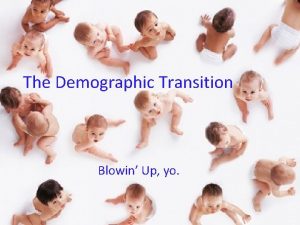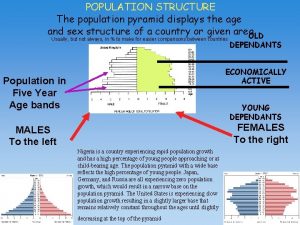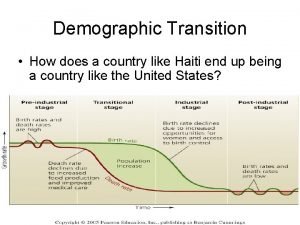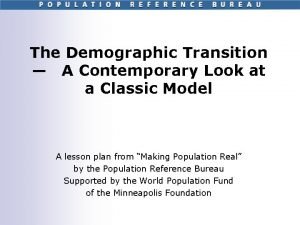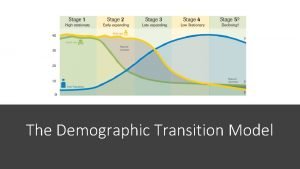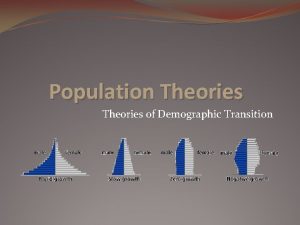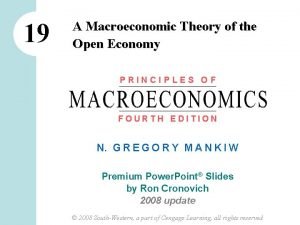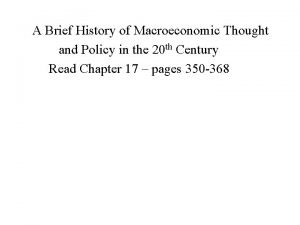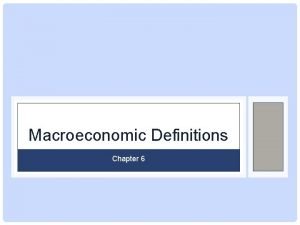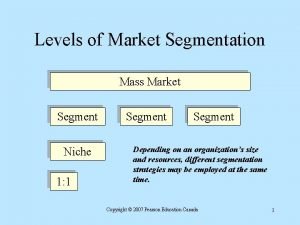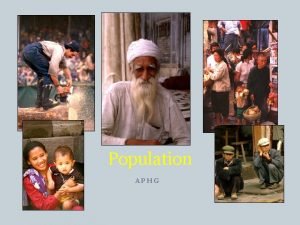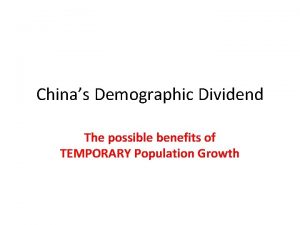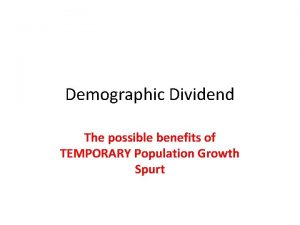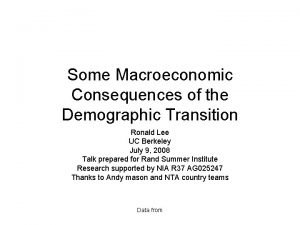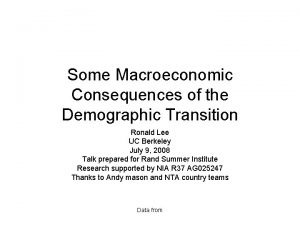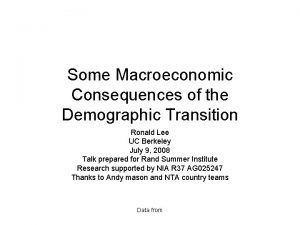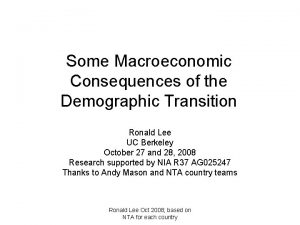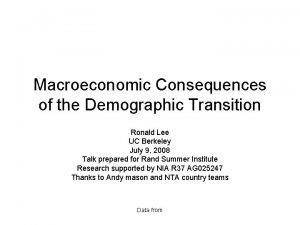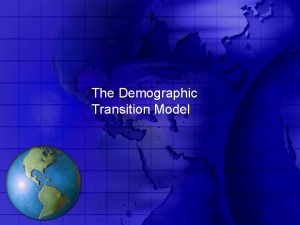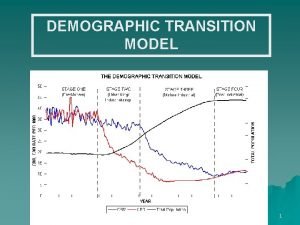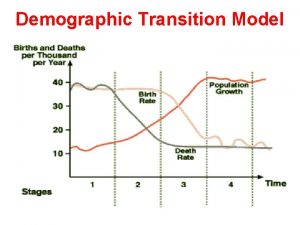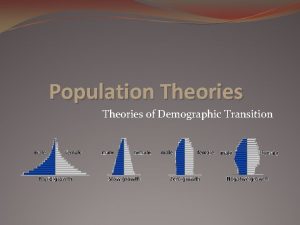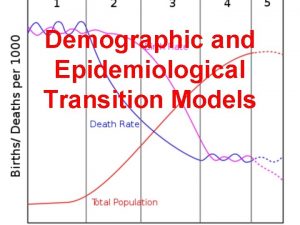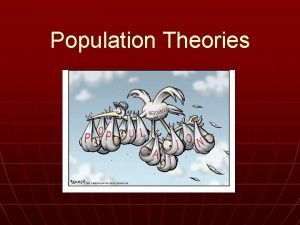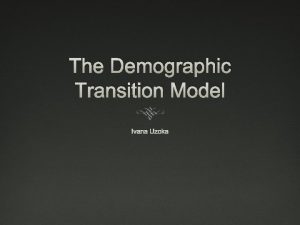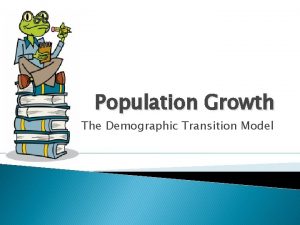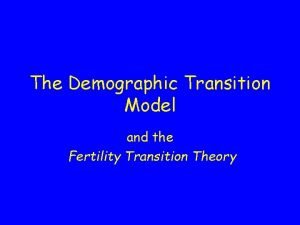Some Macroeconomic Consequences of the Demographic Transition Ronald


































































- Slides: 66

Some Macroeconomic Consequences of the Demographic Transition Ronald Lee UC Berkeley October 27 and 28, 2008 Research supported by NIA R 37 AG 025247 Thanks to Andy Mason and NTA country teams Ronald Lee Oct 2008; based on NTA for each country

Main points, using National Transfer Accounts data 1. 2. 3. 4. 5. 6. Demographic transition first raises support ratio, then with population aging reduces it. Per capita consumption is proportionate to Support ratios, other things equal. “First dividend”, pop aging. Longer life, lower fertility, slower pop growth and older population all raise capital/labor ratio, raising labor productivity. “Second dividend”. This depends on importance of assets vs transfers. Lower fertility goes with greater investment in human capital per child, raising labor productivity. Effects on physical and human capital accumulation are more important than on dependency. Ronald Lee Oct 2008; based on NTA for each country

I. Demographic Transition Ronald Lee Oct 2008; based on NTA for each country

Ronald Lee Oct 2008; based on NTA for each country

Pre fertility decline; child dependency ratio rises During fertility decline, child dependency ratio declines Population aging: old age dep ratio rises Ronald Lee Oct 2008; based on NTA for each country

The total dep ratio rises, falls, then rises again, ending up where it started. The changes in the total dependency ratio are transitory. Ronald Lee Oct 2008; based on NTA for each country

But there is a big permanent change: At start, many children and few elderly. At end, few children and Many elderly. Ronald Lee Oct 2008; based on NTA for each country

Support ratio • Effective workers per effective consumers • Like inverse of dependency ratio • But based on age profiles of labor income and consumption (more on this later) Ronald Lee Oct 2008; based on NTA for each country

Population aging First Dividend Ronald Lee Oct 2008; based on NTA for each country

II. The economic life cycle: • Concern about pop aging is mostly about old age dependency. • Sharpest concerns for age-sensitive public sector programs – pensions – health care – Long term care • But should place these in broader context – Full range of public programs – Private consumption – Labor across the life cycle Ronald Lee Oct 2008; based on NTA for each country

Includes self employment, wages, unpaid family labor, & fringe benefits. Averages 0’s and both male and female. Includes both private expends and in-kind public transfers (health, education, long term care) Ronald Lee Oct 2008; based An. Chi Tung, Taiwan NTA

Flat cons age profile in adult years reflects extended family sharing. Quite different than most industrial nations. Ronald Lee Oct 2008; based An. Chi Tung, Taiwan NTA

Large deficits at young and old ages. Ronald Lee Oct 2008; based An. Chi Tung, Taiwan NTA

Reallocations from surplus to deficit ages required. Ronald Lee Oct 2008; based An. Chi Tung, Taiwan NTA

Other incomes from assets, foreign loans, and remittances from abroad—it’s not all labor income. Ronald Lee Oct 2008; based An. Chi Tung, Taiwan NTA

Asset income is partic Impt for old age Ronald Lee Oct 2008; based An. Chi Tung, Taiwan NTA

Ronald Lee Oct 2008; based on NTA for each country

Ronald Lee Oct 2008; based on NTA for each country

Components of US Consumption, 2003 Unlike Taiwan and other Third World, in US cons rises strongly with age. True in other industrial too. Later I will measure HK investment As sum of pub and priv spending on hlth and educ as shown here. Ronald Lee Oct 2008; based on NTA for each country

• Levels of age profiles change fast with economic development. • Shapes of age profiles change slowly, • Are broadly similar across countries at very different levels of development. Ronald Lee Oct 2008; based on NTA for each country

Many policy possibilities to change the age profiles • labor income – – Later retirement (pension structure) Earlier entry into labor force Higher female labor force participation Reform seniority system • Change the age profile of consumption – In many industrial nations, the elderly consume much more than younger adults. – Makes population aging more costly – Role of public transfer policy: pensions, health care, long term care Ronald Lee Oct 2008; based on NTA for each country

III. Support Ratios • Effective labor is weighted sum of pop using labor income age profile. • Effective consumers is similar. • Ratio of effective labor to effective consumers is the “Support Ratio” (with fixed age profiles). • Other things equal, consumption per effective consumer is proportional to the support ratio. Ronald Lee Oct 2008; based on NTA for each country

2008 Ronald Lee Oct 2008; based on average NTA data

Ronald Lee Oct 2008; based on average NTA data

Ronald Lee Oct 2008; based on average NTA data

Ronald Lee Oct 2008; based on average NTA data

IV. The Life Cycle Deficit Ronald Lee Oct 2008; based on NTA for each country

Per capita consumption and labor income by age for Indonesia and Japan Indonesia, 2002 Japan, 2004 Indonesia NTA Maliki; Japan NTA Ogawa

Here are the aggregate flows: population by age times per capita age profiles Indonesia NTA Maliki; Japan NTA Ogawa

Aggregate flows • Green arrows show transfers from surplus of prime working years. • Red arrows show asset income consumed by elderly out of earlier savings. Indonesia NTA Maliki; Japan NTA Ogawa

Life cycle deficit • Consumption at age x not funded by labor income at that age • c(x) – yl(x) is per capita LCD • C(x) – Yl(x) is aggregate LCD • Or for an age segment: • C(65+) - Yl(65+), consumption by all those over 65 minus labor income for same. • Now measure as ratio to total consumption Ronald Lee Oct 2008; based on NTA for each country

Japan Kenya Ronald Lee Oct 2008; based on NTA for each country

Actual is 50% higher for oldest, Japan Ronald Lee Oct 2008; based on NTA for each country

The rising LCDs as the population ages translate into a rising demand for wealth. Individuals need some kind of claim on future resources to consume more than they expect in labor income. These claims are called “wealth” Ronald Lee Oct 2008; based on NTA for each country

Why does the demand for wealth rise over the demographic transition? • Pure demographic composition effect – Older people need more wealth and hold more weatlh – in old population, there are more of them. • Also behavioral effects driven by demographic change: – Longer life means workers need to accumulate more wealth for longer old age (or work longer). – Lower fertility means adults consume more and need to save more to maintain in old age. Ronald Lee Oct 2008; based on NTA for each country

VI. The role of intergenerational transfers • Wealth can be held in two forms: – Transfer wealth (expected future transfers received minus expected future transfers made) – Assets or Capital Ronald Lee Oct 2008; based on NTA for each country

NTA data gives shares of old age support from different sources • Asset income (land, equities, interest, etc. ) • Family transfers (not including bequests at death) • Public transfers (Pay As You Go pensions, health care, and long term care) • Triangle graph shows shares, not levels, so must add to 100%. • Bequests not included; just old age cons. Ronald Lee Oct 2008; based on NTA for each country

Familial transfers equally important in Thailand, Korea, and Taiwan (36 -40%). Net familial transfers near zero in US, CR, and J. Large public transfers in CR and J Net public transfers to elderly are zero in Thailand; about 25% in Taiwan and Korea. Ronald Lee 2008; from Andy Mason, NTA

Public transfers: Thailand none, Japan and Costa Rica around 70% US, Korea, Taiwan, middling Ronald Lee 2008; from Andy Mason, NTA

Reliance on assets : Japan, Taiwan, C. R. are low; Thailand high; US middling Ronald Lee 2008; from Andy Mason, NTA

VII. Demographic Transition and Capital Accumulation • Changing dependency gets most attention for ec dev and pop aging. • Changes in capital accumulation may be more important. Ronald Lee Oct 2008; based on NTA for each country

Simulating the demand for wealth and capital over the demographic transition • There are different theoretical approaches. We have used several. – Social Planner maximizing discounted social welfare function. – Individuals saving and consuming over their life cycles to maximize their life time utility, given different transfer systems. • Yield qualitatively similar result: capital intensity rises strongly over the demog transition. Ronald Lee Oct 2008; based on NTA for each country

Here take a different approach – no optimization--emphasizes institutional setting • Assume – share of old age consumption supported by asset income stays constant over time. – altruistic sharing maintains the shape of the cross sectional consumption age profile. – Demography is known in advance. • Can solve recursively for unique growth path and asset holdings. Ronald Lee Oct 2008; based on NTA for each country

Two scenarios: high level of transfers to elderly (65%) or low level (35%) as share of life cycle deficit. • Other assumptions – Productivity growth raises income age profile by 2% per year. – Open economy, so wages, interest rates are given. – rate of return on assets is 3%. • Aggregate saving is calculated to maintain asset share of old age consumption support. • Results will be shown relative to a 2% growth trajectory from prod gr. Ronald Lee Oct 2008; based on NTA for each country

Simulated Saving Rate, ASEAN (S. E. Asian countries), 1950 -2050 Ronald Lee Oct 2008; from Mason, Lee and Lee, 2008

Simulated Assets/Labor Income, ASEAN Ratio of assets to labor income rises greatly in any case, but 3 or 4 times as much with low IG transfers. Ronald Lee Oct 2008; from Mason, Lee and Lee, 2008

Simulated Consumption, ASEAN With low IG transfers, saving is higher from 1990 to 2020, reducing consumption. Thereafter, consumption is higher. Ronald Lee Oct 2008; from Mason, Lee and Lee, 2008

These sorts of results are qualitatively like those from optimization approaches • • • Timing of swings differs Level of savings rates differs Capital/labor income ratios differ Big picture is the same: 1. The demographic transition leads to a major increase in capital per worker. 2. The greater the role of transfers to the elderly, the smaller is the increase in capital intensity. 3. Eventually consumption rises with lower transfers, but initially it is lower. 4. Population aging leads to a decline in savings rates but an increase in capital intensity. Ronald Lee Oct 2008; based on NTA for each country

VIII. Human capital and the demographic transition • Measure public and private expenditures on health and education at each age. – Sum these for health ages 0 -18 – Sum for education ages 0 -26 – Gives synthetic cohort HK investment per child • Construct ratio of HK to average yl(x)= ages 30 -49. • Plot log of HK/ against log of TFR. Ronald Lee Oct 2008; based on NTA for each country ,

Ronald Lee Oct 2008; from Lee and Mason, 2008, NTA

Ronald Lee Oct 2008; from Lee and Mason, 2008, NTA

y = -1. 05*x + 1. 92 R 2 = 0. 62 Ronald Lee Oct 2008; from Lee and Mason, 2008, NTA

Now calculate total HK spending on all children • Multiply TFR times HK per child, and plot its log against log(TFR). Ronald Lee Oct 2008; from Lee and Mason, 2008, NTA

6. 8 years of labor income are invested in total HK on average. 1/12 of lifetime labor income for a couple. Ronald Lee Oct 2008; from Lee and Mason, 2008, NTA

The standard Quantity-Quality model • Assume that the share of total labor income spent on HK is fixed, consistent with scatter plot. • Draw budget constraints for differing levels of income. • Quantity and quality interact multiplicatively in the budget constraint, both with positive income elasticities for constant price. Ronald Lee Oct 2008; from Lee and Mason, 2008, NTA

Nonlinear Quantity-Quality budget constraint. Yn = lifetime income of a couple. Lines show different combinations of number and HK that = Yn/12 Ronald Lee Oct 2008; from Lee and Mason, 2008, NTA

With same data, plot ln(HK/w) instead of HK, against ln(TFR) instead of n. The budget lines collapse onto a single straight line. Ronald Lee Oct 2008; from Lee and Mason, 2008, NTA

Ln(HK)/Yn Ln(TFR) Ronald Lee Oct 2008; from Lee and Mason, 2008, NTA

Slope (elasticity) = -1 Similar to empirical crossnational scatter plot. Ronald Lee Oct 2008; from Lee and Mason, 2008, NTA

Association is non-causal • We don’t know whether fertility decline causes rising HK investments per child. • Desire to make bigger HK investments causes fertility decline. • Some other factor like rising income causes both fertility and HK changes as in quantity-quality theory. Ronald Lee Oct 2008; from Lee and Mason, 2008, NTA

Production and Human capital • Human capital (HK) Baseline Specifications – Portion of wage, W(t), workers invest in their children is inversely related to their fertility, F(t) – Human capital of workers one period later is – HK(t+1) = h(F(t)) W(t) • Wage (W) – Wage is increasing in human capital – W(t) = g(HK(t)) Ronald Lee Oct 2008; from Lee and Mason, 2008, NTA

Model—basic structure • Take fertility variations as given, trace out consequences for HK, wage, consumption. • 3 generations: children, workers, retirees; usual accounting identities. • No saving or physical capital. • HK drives wage growth; wage growth drives HK growth. (Lee and Mason 2008) Ronald Lee Oct 2008; from Lee and Mason, 2008, NTA

Boom (demoraphic dividend) Fertility bust, but consumption remains high Fertility recovers: modest effect on C/EA Bottom line: Low fertility leads to higher consumption. Human capital investment has moderated the impact of fertility swings on standards of living. Ronald Lee Oct 2008; from Lee and Mason, 2008, NTA

During first dividend phase, consumption does not rise as much as support ratio. The difference is invested in HK. That is why ih later periods, consumption is proportionately higher than the support ratio. Ronald Lee Oct 2008; from Lee and Mason, 2008, NTA

IX. Conclusions for changes over the transition • Support ratios change over demographic transition; ending where started, roughly. – Importance in long view may be exaggerated. – In shorter view, pop aging is a painful payback phase. • Bigger effect is on capital intensity – Raises productivity per worker – Raises wealth and asset income • However, increased demand for wealth can be met either by increased asset holdings or through increased transfer wealth. • Major role for policy and institutions at every point; nothing inevitable. • Increased human capital results from low fertility—so closely related to aging: same cause for both. – Raises productivity. Ronald Lee Oct 2008; based on NTA for each country

END Ronald Lee Oct 2008; based on NTA for each country
 Demographic transition model song
Demographic transition model song Demographic transition theory by warren thompson
Demographic transition theory by warren thompson Demographic transition model example
Demographic transition model example Population distribution
Population distribution Population pyramid stage 1
Population pyramid stage 1 Demographic transition theory
Demographic transition theory Demographic transition
Demographic transition Haiti demographic transition model
Haiti demographic transition model Demographic transition model
Demographic transition model Uk demographic transition model
Uk demographic transition model Demographic transition model worksheet
Demographic transition model worksheet Demographic transition model ap human geography
Demographic transition model ap human geography Afghanistan population 2050
Afghanistan population 2050 Demographic transition model stages
Demographic transition model stages Dtm model
Dtm model Two big breaks in the demographic transition
Two big breaks in the demographic transition Chile dtm stage
Chile dtm stage Demographic transition def
Demographic transition def Exclave ap human geography definition
Exclave ap human geography definition Theory of demographic transition
Theory of demographic transition Demographic transition model uk
Demographic transition model uk A macroeconomic theory of the open economy
A macroeconomic theory of the open economy Macroeconomic and industry analysis
Macroeconomic and industry analysis Macroeconomic equilibrium occurs:
Macroeconomic equilibrium occurs: Perdebatan kebijakan makro ekonomi
Perdebatan kebijakan makro ekonomi Five debates over macroeconomic policy
Five debates over macroeconomic policy Macroeconomics deals with?
Macroeconomics deals with? Six debates over macroeconomic policy
Six debates over macroeconomic policy Basic macroeconomic relationships
Basic macroeconomic relationships Unemployment
Unemployment History of macroeconomic thought
History of macroeconomic thought Macroeconomic definitions
Macroeconomic definitions 5 debates over macroeconomic policy
5 debates over macroeconomic policy Five debates over macroeconomic policy
Five debates over macroeconomic policy Why have some nations begun transition to free enterprise
Why have some nations begun transition to free enterprise Example of expository paragraph
Example of expository paragraph They say sometimes you win some
They say sometimes you win some Fire and ice diamante poem
Fire and ice diamante poem God when you choose to leave mountains unmovable
God when you choose to leave mountains unmovable Some say the world will end in fire some say in ice
Some say the world will end in fire some say in ice Cake countable or uncountable noun
Cake countable or uncountable noun Some trust in horses
Some trust in horses Contact and noncontact forces
Contact and noncontact forces Demographic imperative intercultural communication
Demographic imperative intercultural communication Sources of demography ppt
Sources of demography ppt Demographic dimensions of consumer market
Demographic dimensions of consumer market Tesco demographic segmentation
Tesco demographic segmentation Bts fan age demographic 2020
Bts fan age demographic 2020 Recent demographic changes in the uk
Recent demographic changes in the uk Levels of segmentation
Levels of segmentation Demographic momentum ap human geography definition
Demographic momentum ap human geography definition Epidemiological transition model
Epidemiological transition model Trends shaping hrm
Trends shaping hrm Broacoes
Broacoes Significance of the study example
Significance of the study example Demographic dividend china
Demographic dividend china Avoiding discrimination through causal reasoning
Avoiding discrimination through causal reasoning Biohacking market demographic
Biohacking market demographic Old woman
Old woman Demographic cohort
Demographic cohort Galapagos
Galapagos Pyramid ratio analysis
Pyramid ratio analysis Starbucks wheel
Starbucks wheel Demographic data definition
Demographic data definition Flows definition ap human geography unit 1
Flows definition ap human geography unit 1 Pringles target market
Pringles target market Geographic demographic psychographic
Geographic demographic psychographic
